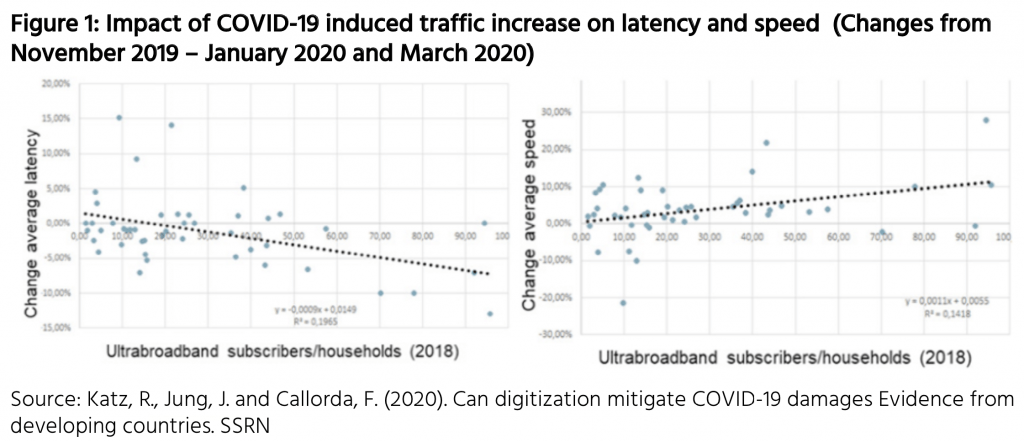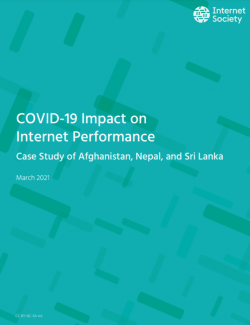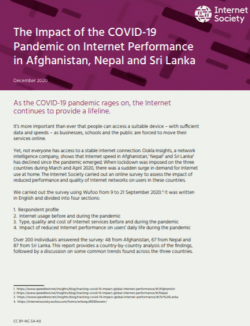Editor’s note: In December 2020, we published The Impact of the COVID-19 Pandemic on Internet Performance in Afghanistan, Nepal and Sri Lanka – Survey Report, which shares users’ perspective on Internet performance in the three countries. In March 2021, we published COVID-19 Impact on Internet Performance – Case Study of Afghanistan, Nepal, and Sri Lanka, a report that holistically examines the state of Internet infrastructure, performance, network resilience and discusses insights on how to strengthen Internet performance in same countries.
Internet is an empowering tool that enables its users to learn, earn and be entertained. Its inherent borderless, decentralized, and all-inclusive design principles encourage provision of meaningful access to everyone, without any discrimination.
When the COVID-19 pandemic hit at the turn of 2020, it challenged the foundations of social and economic norms around the world. One after the other, countries initiated lockdown protocols and social distancing procedures for public safety that shifted daily routines to telecommuting, online education, video calls and digital banking.
As the center point of this ‘new normal’, Internet infrastructure came under huge stress. Global peak traffic increased by 47%, compared to a forecasted 28%, with some services like Facebook video calling (which saw a 100% increase) and Netflix (which welcomed 16 million new subscribers) driving the change and duration of the peak traffic patterns[1] . Global Wi-Fi traffic also increased PC (personal computer) uploads to cloud computing platforms and video calls surged by 80%, while Internet Exchange Point (IXP) traffic in AsiaPacific grew by 40%.[2]
Such traffic surges have posed a question mark about the capacity and reliability of the Internet, while at the same time, reminding us that half of the world is still not online. To ensure the Internet functioned smoothly, governments and service providers launched numerous emergency initiatives, including flexible spectrum use, additional spectrum release, increased international and domestic capacity, subsidized broadband services, and free access to online resources.
The industry also stepped forward and offered free data and voice minutes, leniency in the pay-back period, complimentary access to paid content, and cooperation in relief efforts and disseminating information on COVID-19 safety measures.
In general, the Internet remained resilient enough to respond to the traffic spikes. However, it is clear that this resilience has not been uniform across the world, simply because countries are at varying levels of digital readiness.
As figure 1 shows, countries with a higher deployment of ultra-fast broadband infrastructure responded better to the COVID-19-related traffic surge – it would appear that the more fiber there is, the fewer traffic spikes there will be. It is therefore of utmost importance that an open, secure, and globally connected Internet is equally available as a fundamental right, to everyone in the world, to survive through this and future pandemic.

Scope of the Study
The purpose of this study is to compare network performance in Afghanistan, Nepal, and Sri Lanka, pre and post COVID-19. Section 3 shows that Internet speed in Afghanistan, Nepal, and Sri Lanka declined due to traffic surges during the COVID-19 lockdown period. In this study, we will identify the weak elements of Internet infrastructure in these three countries by analyzing the international and domestic Internet infrastructure. We will explore the factors behind reduced network performance and examine user perspectives on how COVID-19 impacted their online experience. We also suggest how these countries can address infrastructure gaps in the short and long term.
Below is a snapshot of the three countries covered by this study.
| Indicator | Afghanistan | Nepal | Sri Lanka |
| Population (in millions) | 38.04 | 30.4 | 22.9 |
| Land area (in sq. km) | 652,230 | 147,181 | 65,610 |
| Literacy rate (in %) | 43 | 67.9 | 91.9 |
| GDP per capita (in USD) | 2,294 | 3,558 | 13,620 |
| GNI per capita (in USD, PPP) | 540 | 1,090 | 4,020 |
| Lockdown period | 22 March-24 May | 23 March-14 June | 20 March-11 May |
Endnotes
[1] Analysys Mason (2020), https://blog.telegeography.com/internet-traffic-and-capacity-in-covid-adjusted-terms
[2] Katz, R., Jung, J. and Callorda, F. (2020). Can digitization mitigate COVID-19 damages? Evidence from developing countries. SSRN, https://www.internetsociety.org/blog/2020/07/holding-steady-how-cdns-ixps-and-network-providers-help-keep-us-online

